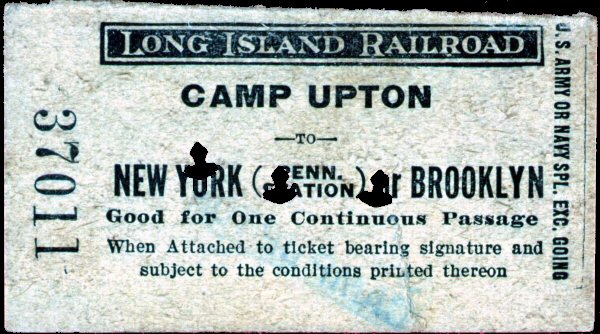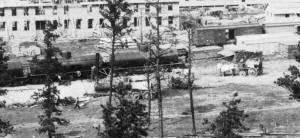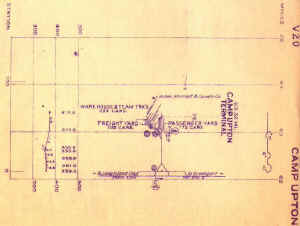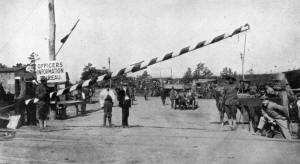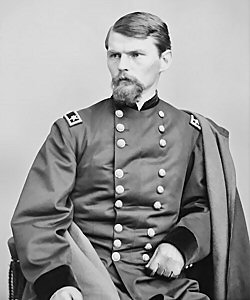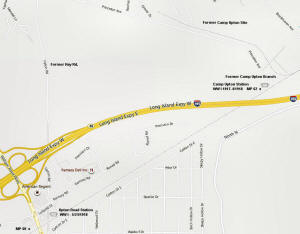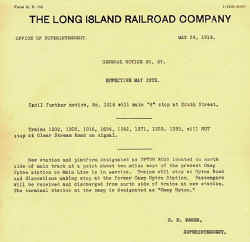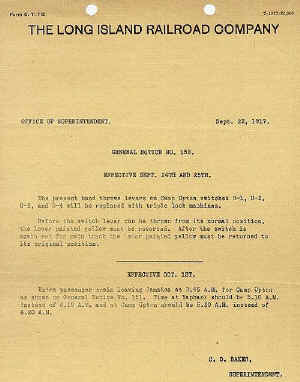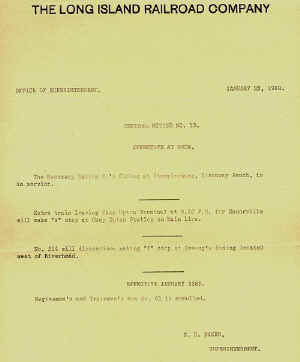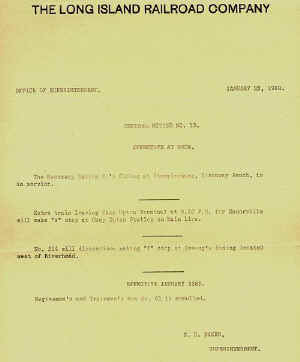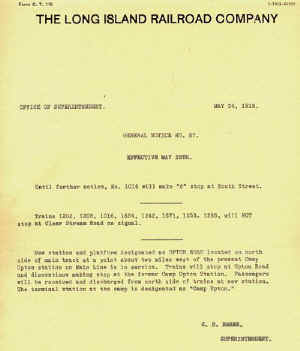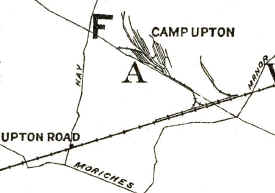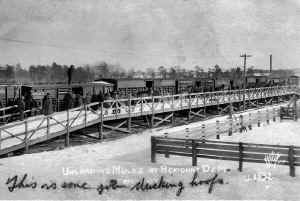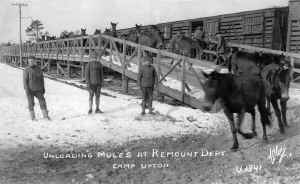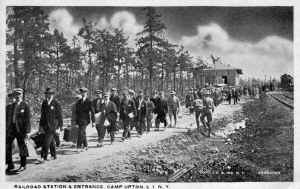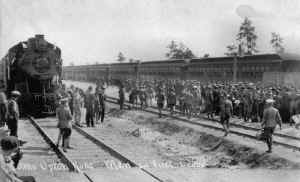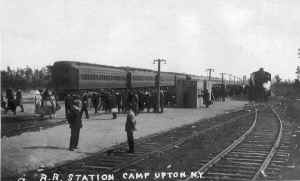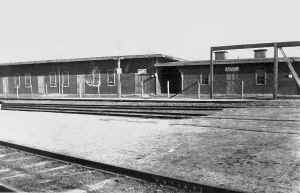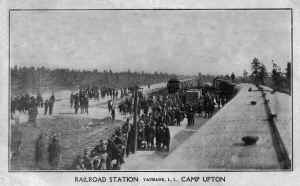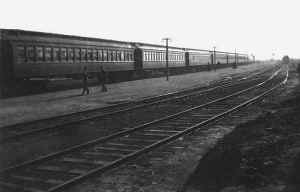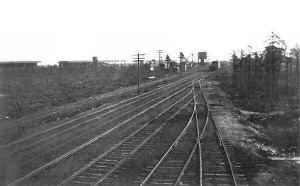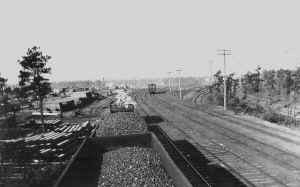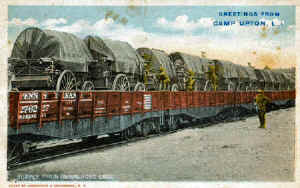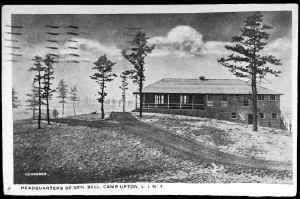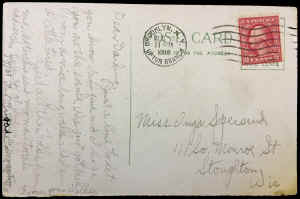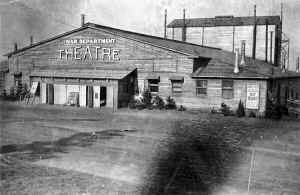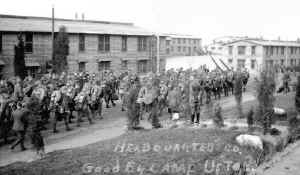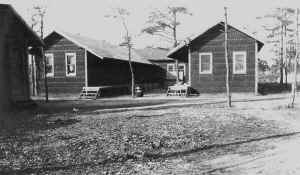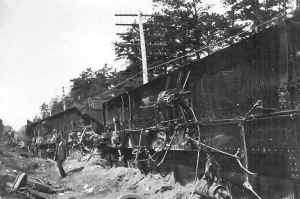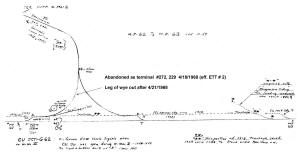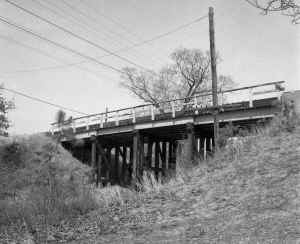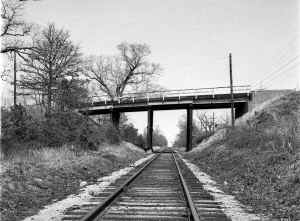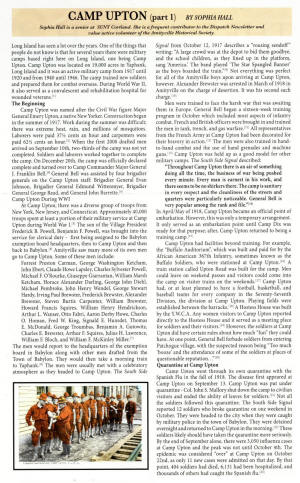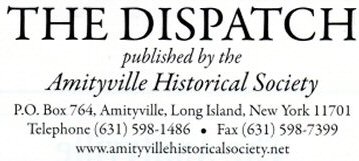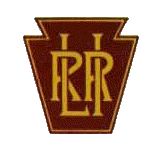 CAMP
UPTON
CAMP
UPTON |
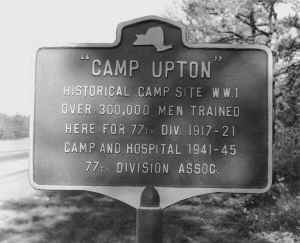 NY State historical marker for the Camp along William Floyd Pkwy View N 1987 (Dave Keller photo) |
||||
|
|
|
||||
|
Upton Road was in service May 28, 1918 and was last listed in public TTs of 10/16/1921 but with no station stops scheduled. I can't imagine what sort of ridership was generated between there and Medford to have PRINTED TICKETS issued for sale! My thought is that Patchogue-Port Jefferson Road (later Rt. 112) was THE main north-south road in that part of the island and it ran right next to the Medford station. There wasn't any direct route at the time to Upton Road, so perhaps people visiting the camp would take a bus along Patchogue-Port Jefferson Road to Medford, then catch the train to Upton Road and then a shuttle bus from there into the camp. Just a thought, but the only explanation I could think of that would require the printed
tickets!
Info: Dave Keller |
|||||
|
UPTON
ROAD STATION EAST OF YAPHANK AND APPROX. 2 MILES W. OF UPTON JCT., AND THE
FORMER CAMP UPTON STATION, WHERE THE OLD HAY RD (UPTON ROAD IN 1918) CROSSED
THE TRACKS. LOCATED ON NORTH SIDE OF TRACKS, NEW STATION IN SVC. EFF:
05/28/1918 PER G. N. #87. STILL LISTED ON PUBLIC TT OF 10/16/1921 BUT NO
TRAIN SERVICE INDICATED. PER THOS. R. BAYLES, TICKET CLERK AT CAMP UPTON,
LIRR SERVICE TO /FROM THE CAMP ENDED: 04/1922. CAMP UPTON: UPTON SPUR OPENED ON THE CAMP GROUNDS: OFF MAIN LINE c. 1942. NO INDICATION OF A TICKET OFFICE / DEPOT BLDG. TROOPS WERE LOADED AND OFF-LOADED ON THE MAIN LINE AT THE SITE OF THE FORMER WW I ERA UPTON ROAD STATION, AT THE UPTON ROAD OVERPASS. (Robert Emery map data) LIRR SVC. TO THE CAMP ENDED: c. 1946 (?) Research: Dave Keller WC CABIN: CAMP UPTON JCT.- JUNCTION OF CAMP UPTON SPUR AND MAIN LINE. (WW I) WEST OF WAMPMISSICK SIDING per Richard Makse. FORMERLY THE UNUSED “CP” CABIN ERECTED AT CENTRAL ISLIP. LOADED ON FLATCAR AND RELOCATED HERE FOR START OF MANUAL BLOCK SVC: 1916 per George G. Ayling, block operator at “CI”: 1910-1923, Agent/Operator: 1923-1954. INDICATED ON 1916 VALUATION MAP. OUT OF SVC: ETT #94 EFF. 1921. |
|||||
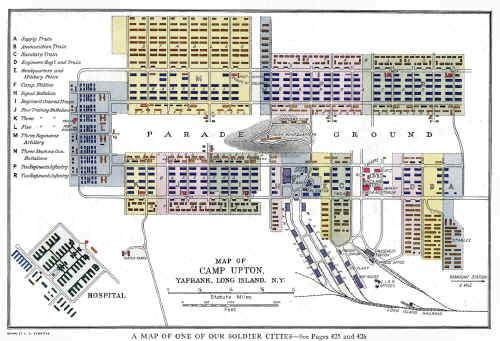 Camp Upton map National Geographic Nov-Dec 1917Archive: Dave Morrison |
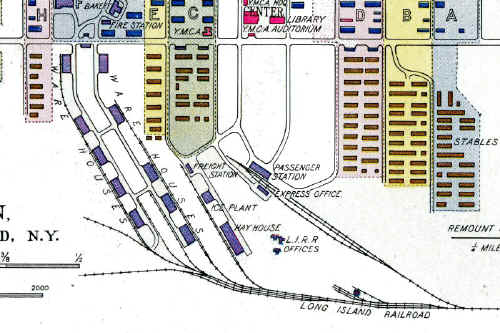 Camp Upton - LIRR facilities National Geo. Nov-Dec 1917 Archive: Dave Morrison |
||||
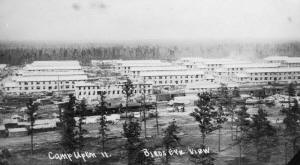 Camp Upton Freight Yard - c.8/1917 Archive: Dave Morrison
August 27, 1839 - March 15, 1881 Place of burial: Fort Hill Cemetery, Auburn,
NY Upton was commemorated at a site in central Suffolk County, New York, presently occupied by Brookhaven National Laboratory. The U.S. Army's Camp Upton was active from 1917 until 1920, and again from 1940 until 1946. During World War II, the camp was rebuilt primarily as an induction center for draftees. The Army later used the site as a convalescent and rehabilitation hospital for returning wounded.
|
This is early days in the camp's history as the barracks are under construction. Thomas R. Bayles said the LIRR began operations into the camp in August, 1917. He was there from day one and was the last man out when the LIRR ended operations there in April, 1921. He stated in his history of the camp the first 2,200 men drafted arrived Sept. 10th and 30,000 by the end of October, 1917.
The
photo was shot in mid-late August or very early September, 1917, as the
LIRR's tracks were already in place, but the barracks are incomplete. A
portion would have to be serviceable by the Sept. 10th arrival of draftees,
so the photo would have to have been taken prior to September 10th.
Long, tar-papered ticket office alongside tracks. Sign over the door reads "LIRR Ticket Office". Note what looks like the island platform in the foreground. I believe the square depot was to the right, outside the photo, and was removed once the long depot was constructed. Both images, above, show the pedestrian crossing over the tracks and two tracks on one side of the platform and one on the other side, and if you look at the Nat'l Geo. map, you'll see that the track configuration matches at the station AND the square depot would have been across from the express house.
|
Camp Upton was located on the site of the Brookhaven National Laboratory, on a tract of about ten thousand acres, east of the William Floyd Parkway and extending from the Middle Country Road to the Montauk Highway. Later, several thousand acres were purchased north of the Middle Country Road and west of Lake Panamoka for a rifle range. On June 21, 1917, Col. Frank M. Lawton, of the Department of the East and Ralph Peters, President of the Long Island Rail Road, made an inspection of the property, which had been determined from a U. S. Geological map of the area. The location of the camp was approved and the contract for the construction of the camp was let to Thompson Starrett Co. on June 24th. Work during that summer was very difficult, with extreme heat, rain and millions of mosquitoes, which made working conditions almost unbearable. Rates paid for labor were $.375 an hour for laborers and $.625 per hour for carpenters. The men were fed in commissaries operated by the contractor and the prices charged for meals were $.25 for laborers and $.35-$.40 for mechanics. The largest number of men employed on any one day was 15,000. A total number of 5,742 carloads of lumber and other materials were used in the construction of the camp. The Long Island Rail Road extended tracks for the two miles into the camp from the main line, with tracks running to the passenger station, the freight yards, coal trestle and to the ten warehouses where merchandise was received for the operation of the camp. The first 2,200 drafted men arrived on Sept. 10th and up to the end of October about 30,000 men arrived. The camp was built to accommodate 37,000. A station called Upton Road was built on the railroad east of the present William Floyd Parkway and a shuttle train was operated into the camp from the Main Line that met the trains, in addition to the trains operating into the passenger station in the camp. Trains were operated on Saturday mornings to New York about an hour apart for the thousands of men on weekend passes, and returned Sunday night. Also, visitors’ trains from New York came into the camp on weekends, bringing thousands of the relatives and friends of the men in the camp. Tickets for the soldiers were sold at $1.30 for a round trip to New York. The railroad station was a busy place in those days. That first winter of 1917-1918 was a hard one with lots of snow, ice and muddy roads in the spring, as most of the roads were not hard surfaced at that time and the only hard surfaced road out of the camp was the one to the Montauk Highway, four miles distant. The Barrett Company had the contract for building the roads in the camp. The Longwood Road and the old “Hay Road” that came into the camp from the Middle Country road were dirt roads and became almost impassable that winter. At one time the mud was so bad that autos and trucks could not get around and mule teams were used for trucking. Irving Berlin, the famous songwriter, was an early soldier in Camp Upton, and with all the other men hated to get up in the morning when the bugle blew, so he wrote the song “Oh How I Hate to Get Up in the Morning,” which became an instant success. He got many Broadway performers to come out to the camp and entertain the soldiers in the camp theater and he directed a musical comedy called “Yip Yip Yaphank,” which soon became famous and had a short Broadway run. Thousands of men were trained at Camp Upton during 1917 and 1918 and went overseas. The men of the 77th Division were trained there and most of them were from the New York and Long Island area. After the war ended in November 1918 the camp was made into a debarkation camp, as the men returned from overseas to be discharged. The American Railroad Association had an office with 24 hour telephone switchboard service and handled all the railroad operations for the troop movements in and out of the camp. The railroad ticket clerks worked nights making up the tickets for the lists of men who were being sent out the next day to their homes all over the country. The army had thousands of mules that were kept at the old ‘Remount’ in the part of the camp near the main line of the railroad. These were sold at auction and shipped around the country. We had a train of 50 stock cars with engine attached backed to the loading platform and, as the mules were sold, they were lassoed and the government brand burned off, then herded up the loading platform and loaded 21 mules in a car. As each car was loaded the train moved ahead to the next car until the train was loaded. The waybills were given to the train conductor and the train departed. The 1,660 buildings, utilities and improvements in the camp were sold at auction on August 21, 1921 by the auctioneers Smith & Jaffee. Everything was to be removed within 60 days and the purchasers took down the buildings and salvaged the lumber in them. Hundreds of carloads were shipped around the country as far west as Indianapolis, Indiana. Some of the smaller buildings were moved to various location on Long Island. The pot bellied stoves that were used to heat the barracks were sold and shipped to Pittsburgh, Pa. to be reconditioned and sold by the mail order houses, as were the army cots, by the thousands. I was employed by the Long Island Rail Road in the freight department at Camp Upton for the five years the railroad operated there, from August, 1917 to April 15, 1922 and was the last man on duty when we closed the freight office in April, 1922. I could write a great deal about those years in Camp Upton but space forbids. A detailed report of the construction of the camp by Major O’ K Myers, the Construction Quartermaster, is in the Middle Island Public Library and may be inspected by anyone interested. Thomas R. Bayles, 1974 Unfortunately, Tom Bayles never wrote down that wealth of Camp Upton information he mentioned as having and it is now lost to history. Dave Keller
Art Huneke has kindly provided the following list displaying some of the amazing numbers of people, trains and freight handled at the camp during WWI: 1. 543,830 tons of freight handled 2. Over 1 million troops handled on 1,954 trains 3. Over 1.1 million furloughed troops and visitors handled on 2,040 trains
Article on the War-Time construction of Camp Upton the Engineering News Record, 8/23/1917
Additional Camp Upton Postal Material: CLICK
|
|||
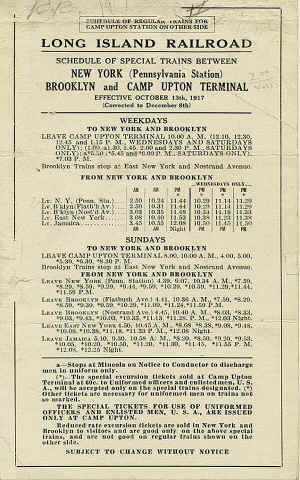 LIRR train schedule for Camp Upton 1917 (page 1) (Courtesy of Art Huneke) |
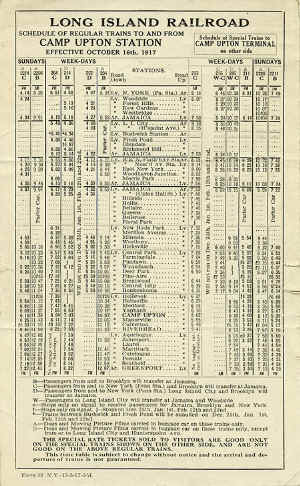 LIRR train schedule for Camp Upton 1917 (page 2) (Courtesy of Art Huneke) |
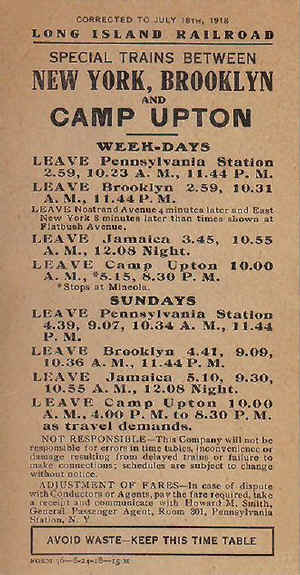 Special LIRR Form 36 timetable for |
|||
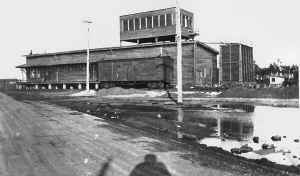 Refrigeration house with Armour Star reefer car – 1918 (Bayles-Keller)
|
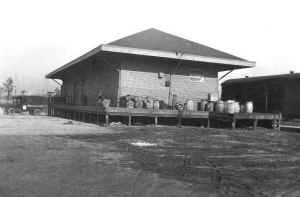 Camp Upton Express House- rear view – 1918 (Bayles-Keller) 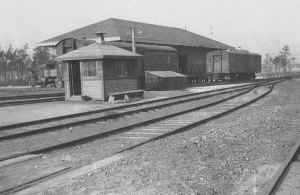 Express house – front view showing express cars at platform, Yardmaster’s shanty (cabin) and doughboy walking with his rifle shouldered - 1918 (Bayles-Keller) |
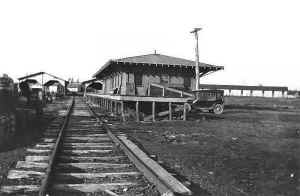 Freight station – side view – 1918 (Bayles-Keller) 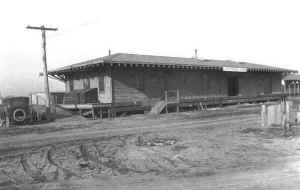 Freight station – rear view – 1918 (this building was later broken down into sections and moved to Northport where it was again put into service as a freight station.) (Bayles-Keller) |
|||
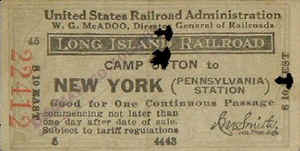 The dater die is identified as clerk #5. In the height of the camp's operation, there must've been quite a few ticket clerks on duty for die #5 to be issued. Most stations only had dies #1 and #2. Terminals like Penn Station had 20 and 30 dies. 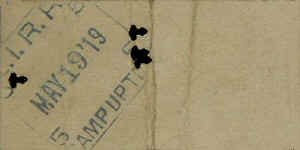 Also, this is a ticket purchased to LEAVE the camp, so unless someone visiting or on business had purchased a one-way ticket to enter the camp and then purchased this separately for the return trip (which makes no sense to do), it appears that the purchaser was someone who was residing at the camp, possibly one of the soldiers demobilizing. May 19, 1919 Info: Dave Keller |
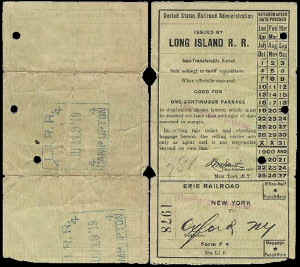 A discharged soldier’s interline ticket over the LIRR and the Erie Railroad, issued at Camp Upton on June 19, 1919 |
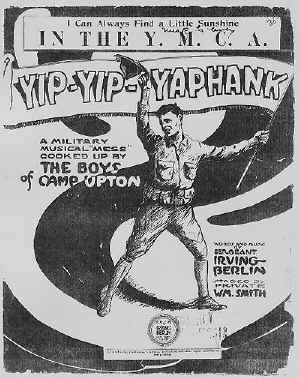 Sheet music to the song, “I Can Always find a Little Sunshine in the YMCA”, copyright, 1918 by Irving Berlin for his production of “Yip Yip Yaphank.” (Collection of Geo. G. Ayling) |
|||
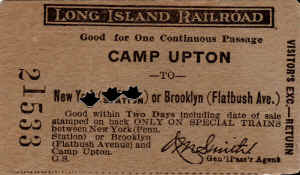 Camp Upton to NY Penn - Visitor Excursion Ticket 10/21/1917 Archive: Brad Phillips |
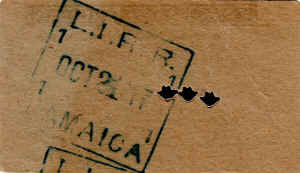 Camp Upton to NY Penn - Visitor Excursion Ticket reverse 10/21/1917 Archive: Brad Phillips |
||||
| "CP" CABIN | |||||
|
CP CABIN: CENTRAL ISLIP (SOUTH SIDE OF TRACKS AND WEST OF STATION. LISTED IN ETT OF 5/14/1916. GONE FROM ETT OF 6/28/1916. CALL LETTERS MOUNTED ON CABIN BUT NEVER PLACED IN SVC. LOADED ON FLATCAR AND RELOCATED TO CAMP UPTON JUNCTION: 1916. RENAMED “WC” CABIN. AGENT AT CENTRAL ISLIP PAID EXTRA TO HANDLE “CI” BLOCK IN TICKET OFFICE. Per George G. Ayling, Block Operator. At “CI”: 1910-1923, Agent/Operator: 1923-1954.) |
|||||
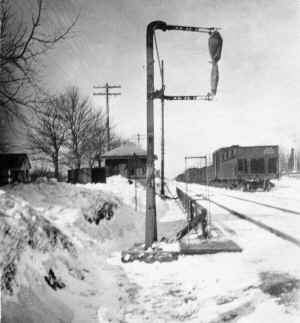 Mail Crane "CP" Cabin Central Islip View W 1916 (Ayling-Keller) |
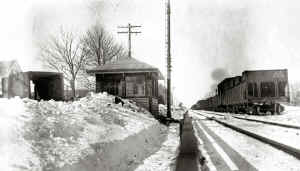 In the winter of 1916, we are looking due west at Central Islip with "CP" interlocking cabin at the left and a freight on the passing siding at the right. George G. Ayling, the block operator, had rested his camera along the top wooden rail of the protective fence used to keep the mailbags tossed off the moving trains from bouncing back up and under the wheels of the train. Notice the trench that has been dug in the snow so the mailbags could be readily retrieved after delivery. (George G. Ayling photo, Dave Keller archive and data) |
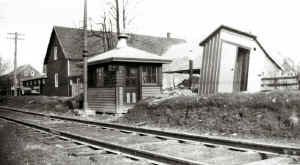 Here is a view of the newly-constructed "CP" interlocking cabin and the Central Islip depot's two-stall outhouse as it all looked in 1916. As mentioned previously, the cabin was never placed in service and was loaded onto a flatcar the following year, moved to Upton Junction, renamed "WC" cabin and used to control train movements into and out of the newly-constructed U. S. Army training facility at Camp Upton east of Yaphank. (George G. Ayling photo, Dave Keller archive and data)
|
|||
|
Looking west after a heavy
snowfall in 1916, we see the mail crane and "CP" interlocking
cabin; photo above left. The mail crane has a U. S. Mail bag suspended from
the frame and is in position for a moving train to capture the bag via the
Railway Post Office car as it heads through Central Islip. The low,
slat fence along the tracks kept mailbags tossed off the train for mail
delivery to the Central Islip Post Office from bouncing and going back under
the wheels of the moving train. "CP" cabin was constructed
for the block operator to handle the semaphore signals, but after building
the structure, the railroad decided it would behoove them to pay the block
operator a slightly higher salary and let him stay in the ticket office to
handle both the train traffic as well as ticket sales. This cabin,
named but never placed in service, was loaded onto a flatcar and taken
further east to the newly-created Upton Junction in 1917 to handle the block
signals at the rail entrance to the U. S. Army's newly-constructed Camp
Upton. (George G. Ayling photo, Dave Keller archive and data) |
|||||
|
Troop Train Wrecked Leaving Camp UptoN - 4/15/1918 |
|||||
|
On April 15, 1918 one of many LIRR
troop trains left Camp Upton and was heading westbound along the Main Line under the control of engineer Tom Kelly when it derailed at speed just east of Foot’s Crossing (the present day crossing of the Veterans’ Memorial Highway over the
LIRR east of Central Islip).
Operator Ayling told me he found out soon afterwards that the wreck was a result of sabotage. He mentioned to me that the train was full of soldiers heading towards New York City and there were many, many injuries. It was later determined that there were 3 soldiers dead and 36 soldiers injured. He said at the time I spoke with him, that he never heard another thing about the wreck. For some reason, the railroad men never got the true story and it was kept quiet at the time. For many years afterward he was afraid to let anyone know that he even had photos of the wreck, for fear that he was breaking some sort of security. I managed to obtain the negatives from him before he passed away. Had this happened today, the media would have been pouring all over the site with helicopter coverage and high-powered zoom lenses and we’d all be watching it on television. And...had George Ayling known the real reason for the wreck, he’d have slept easy. I recently acquired the official ICC report on this wreck and, despite George’s facts, which were obviously typical railroad-man rumor and hearsay of the day, the derailment was a result of defective rails. The reason George never photographed the locomotive, was that it and the first three cars were still on the tracks. Chances are, it was uncoupled from the fourth car whose rear truck had derailed, and left the scene to make way for the wreck train. I’ve scanned the first portion of the ICC report for anyone interested in reading it. It gets extremely technical (i.e. boring) for us non-engineers so at that point I skipped to the very end and scanned the engineer’s summary and closing statement. Info: Dave Keller |
|||||
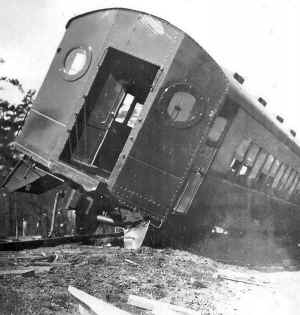 Head-on view of derailed coach |
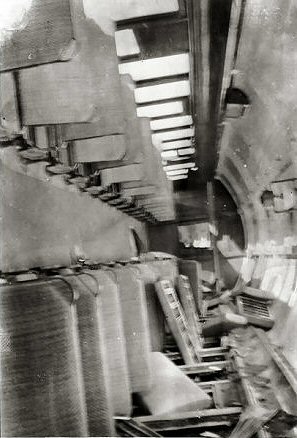 Interior view of derailed coach |
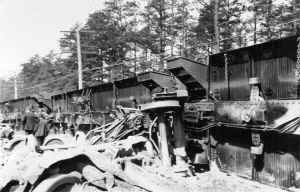 Three coaches laying on their sides
|
|||
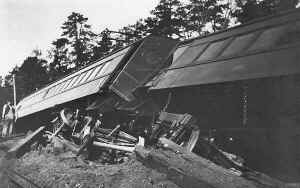 Two derailed coaches and torn-up track |
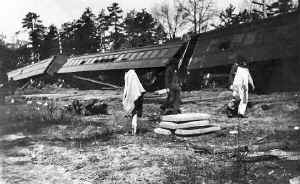 Railroad workers walking past three derailed coaches and torn-up tracks |
George
Ayling’s photos of the wreck |
|||
UPTON JUNCTION by Dave Keller |
|||||
|
CU CABIN:
CAMP UPTON JCT. – JCT. OF CAMP UPTON SPUR WITH MAIN LINE. (IN
SVC: 3/14/44 SOUTH SIDE OF TRACKS, OPPOSITE JCT. OF WEST LEG OF WYE |
|||||
|
“WC” cabin was originally built at Central Islip in 1914 and given the call letters of “CP”, however it was decided not to be put into use, and remained at Central Islip, out of service, until it was loaded on a flatcar and moved out to Camp Upton for use during WWI. A photo of that cabin accompanies my railroad vignette about Central Islip Station Agent George G. Ayling.
As
mentioned by Tom Bayles in his “Camp Upton in World War I” pamphlet,
there was a station just west of the junction on the Main Line called Upton
Road, which was named for the main road going into the camp.
The remains of this bridge used to be visible from the William Floyd
Parkway overpass at the Main Line. I don't know if it's still there or not,
as I no longer live on Long Island. I
photographed it in 1968.
When in use, the junction had a wye and a water tower north of the tracks and west of the west leg of that wye leading into the camp. The west leg of the wye continued for a good distance before connecting with the Main Line . This westward connection was removed in May, 1968. The eastward connection was retained for access into Brookhaven National Laboratory, which occupied the site in later years. That connection is still in use.
During the summer of 1968, at age 16, I slung my camera over my shoulder and rode my bicycle from my house in Holtsville, along the yet unopened and semi-paved stretch of Long Island Expressway out to the site of the “junction”. (The LIE crosses the LIRR Main Line just slightly west of where the junction was.) The water tower and two metal crossing shanties were still standing. The west leg of the wye had been disconnected from the Main Line and from the spur going into Brookhaven National Laboratory. The water tower toppled over a number of years later as a result of a forest fire that swept through the scrub pines. |
|||||
|
|
On
5/28/1918, the Upton Road station was built on the north side of the tracks,
on the east side of that bridge. Part of the station platform extended
across the former grade crossing of Hay Road. This Main Line station
was IN ADDITION to the station in the camp. The stations closed in
1922 when the camp closed and LIRR service to the camp ceased in April of
that year. Upton Road remained the main north-south avenue, following the path of the former Hay Road and, during WWII, became, once again, the main avenue into Camp Upton when it was rebuilt and reactivated. This trestle and road was later made obsolete with the construction of the Wm. Floyd Parkway in 1959 and access into the former camp, now Brookhaven National Laboratory, made from the parkway. I photographed this bridge in 1968. It was torn down shortly after. Research: Dave Keller |
||||
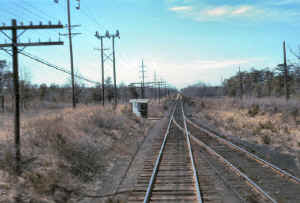 Cabin CU (former) west switch Upton Junction view W Upton 5/03/1964 (Makse-Keller) |
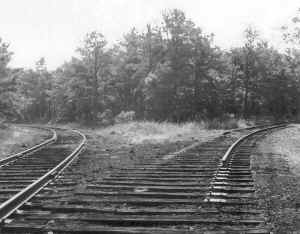 Disconnected west leg of wye at Upton Junction - View S towards Main Line -1968 (Dave Keller photo) |
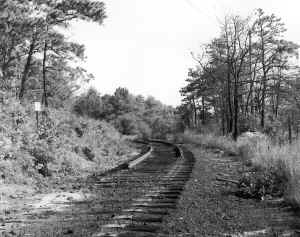 Disconnected west leg of wye at Upton Junction – View NE from Main Line - 1968 (Dave Keller photo) |
|||
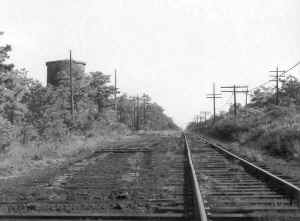 Upton Junction – View E Water tower in background, remains of west leg of wye at left, Main Line at right, 1968 Photo/Archive: Dave Keller |
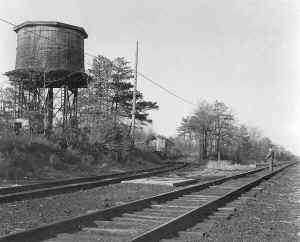 ALCO RS-3 #1556 pulling railfan extra on west leg of wye – Upton Junction 4/21/68 (The wye was disconnected shortly thereafter) Photo/Archive: Dave Keller |
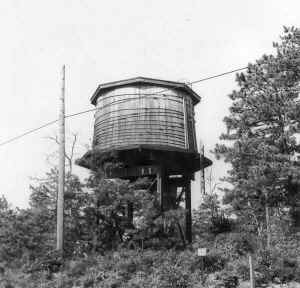 Water tower – View NW– Upton Junction – 1968 Photo/Archive: Dave Keller |
|||
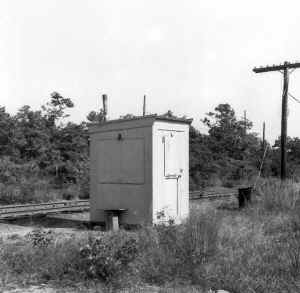 1st crossing shanty looking northeast – Upton Junction 1968 Photo/Archive: Dave Keller |
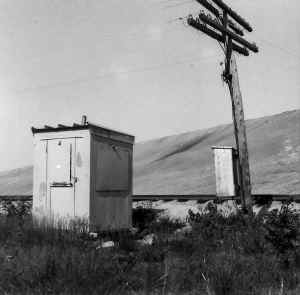 2nd crossing shanty looking northwest – Upton Junction 1968 Photo/Archive: Dave Keller |
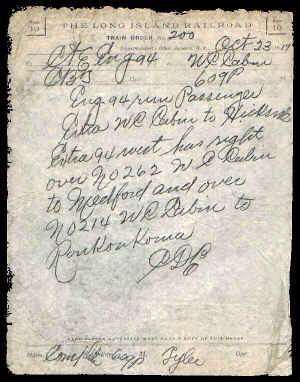 Form 19 train order issued at “WC” cabin, Upton Junction, on 10/23/17 (Dave Keller collection) |
|||
| CAMP UPTON - WW II | |||||
|
CAMP UPTON: UPTON SPUR OPENED ON THE CAMP GROUNDS: OFF MAIN LINE c. 1942. NO INDICATION OF A TICKET OFFICE / DEPOT BLDG. TROOPS WERE LOADED AND OFF-LOADED ON THE MAIN LINE AT THE SITE OF THE FORMER WW I ERA UPTON ROAD STATION, AT THE UPTON ROAD OVERPASS. (Robert Emery map data) LIRR SVC. TO THE CAMP ENDED: c. 1946 (?) Research: Dave Keller |
|||||
 Camp Upton c.1940's Archive: Brookhaven National Lab |
|||||
|
In 1940, the Yaphank wilderness came to life again as the war in Europe and in the Pacific (of which America was not yet a part) gave rise to a drive for military preparation. Since the Yaphank land was still available, the decision was made to rebuild the camp. Once again, plans were drawn up for parade grounds, barracks, and other support facilities. |
|||||
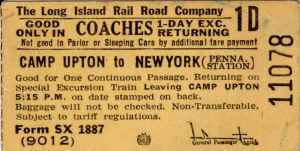 Camp Upton to NY Penn Ticket 11/30/1941 |
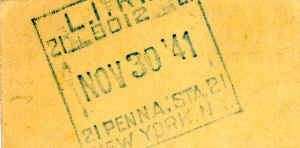
|
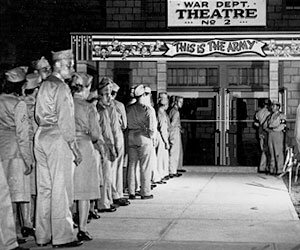 Camp Upton -War Dept Theatre 'This is the Army' 1943 Archive: Brookhaven National Lab |
|||
|
GPA (General Passenger Agent) on this ticket is C. Gordon Pennington. When the LIRR changed to the PRR style tickets (1H, 1BH, etc.), AH Shaw was the GPA (first mention I can find of him is in July 1933 reporting increases in beach traffic). Next was Pennington; I can’t find a date of appointment but he died in 1943 swimming at Montauk! So, the date of the ticket being 1941 Pennington was “in his prime” on the LIRR. Archive/Info: Brad Phillips Note: The ticket says it's a special excursion train, not a regular run. Info: Dave Keller |
|||||
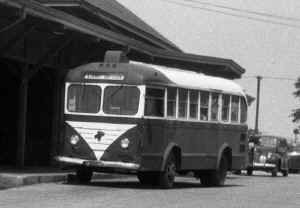 Patchogue Station - Camp Upton Bus - View NE zoom Summer 1941 (T. Bayles-Keller) |
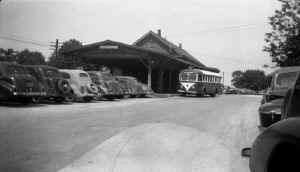 Patchogue Station - Camp Upton Bus - View NE Summer 1941 (T. Bayles-Keller) |
||||
| A CAMP UPTON SOLDIER'S RAIL TRIP HOME | |||||
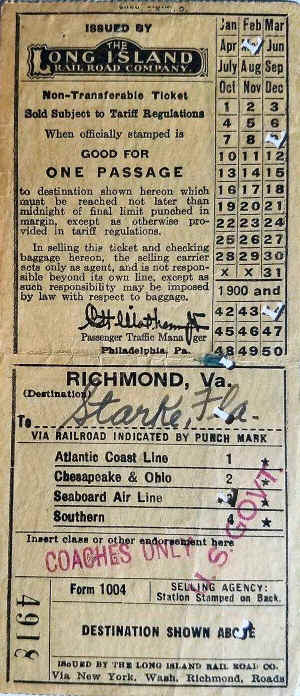 This was known as an interline ticket, sales of which were common at most LIRR stations for many decades. To
create such a ticket, a current copy of Official Guide to the Railways has
to be in all ticket offices so the route could be accurately laid out and
proper connections between railroads made. That
took a skill. Info: Dave Keller
|
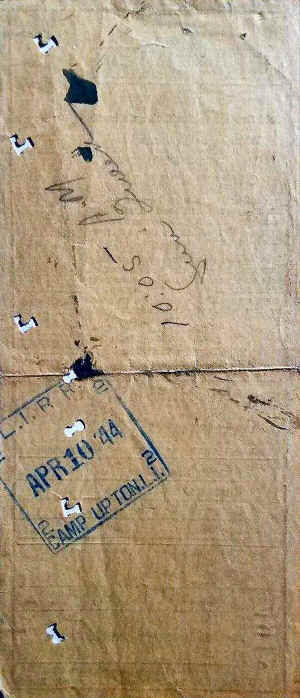 Ticket stamped 4/10/1944 with penned notation on back for the 10:30am "Sun Queen" at PENN Station, NY. SAL Heavyweight named train: 12/12/1941 - 5/18/1947 The route was LIRR to NY Penn Station |
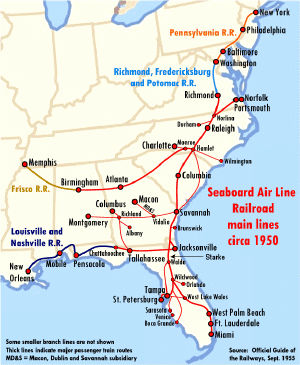 Official Guide of the Railways, Sept. 1955 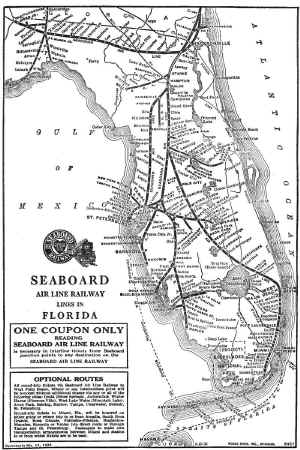 SAL rail lines in Florida 1938 |
|||
| CAMP UPTON HISTORY | |||||
|
|
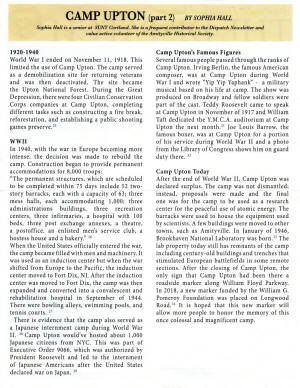 Camp Upton Part 2 by Sophia Hall The Dispatch Q1 2021 - Amityville Historical Society |
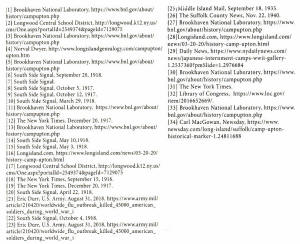 Camp Upton footnotes by Sophia Hall The Dispatch Amityville Historical Society
|
|||
|
|
|||||
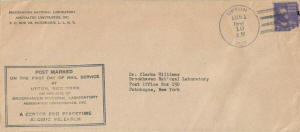
Post marked on the first day of mail service
8/01/1947 |
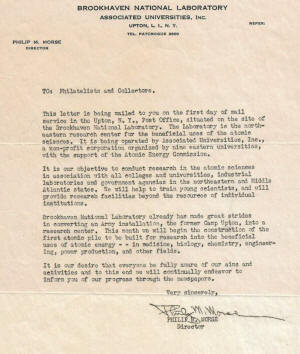 |
||||
.jpg)
